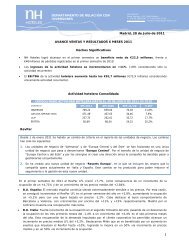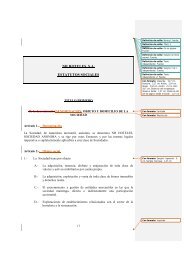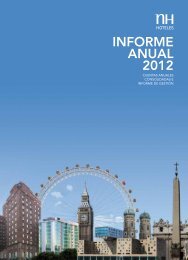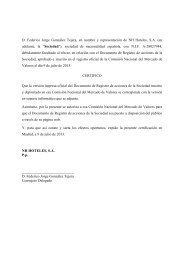Download Complete PDF - Informe Anual 2012
Download Complete PDF - Informe Anual 2012
Download Complete PDF - Informe Anual 2012
You also want an ePaper? Increase the reach of your titles
YUMPU automatically turns print PDFs into web optimized ePapers that Google loves.
- Held-to-maturity financial assets: These are assets subject to a fixed or determinable redemption amount with a fixed maturity date. The<br />
Group declares its intention and its capacity to keep these in its power from the date of acquisition to their maturity date.<br />
- Outstanding loans and accounts receivable generated by the Company: These are financial assets generated by the companies in exchange<br />
for deliveries of cash or the supply of goods or services.<br />
Negotiable financial assets are valued after their acquisition at fair value, and any changes are included in the net profit/loss for the financial year.<br />
Fair value of a financial instrument on a given date is (construed as) the amount for which it could be bought or sold on that same date by two<br />
knowledgeable parties acting freely and prudently under conditions of mutual independence.<br />
Held-to-maturity financial assets and accounts receivable issued by the Group are valued at their depreciated cost and any interest accrued is<br />
recognised in the consolidated comprehensive profit and loss statement on the basis of their effective interest rate. Depreciated cost is construed<br />
as the initial cost minus any charges or depreciation of the principal, considering any potential reductions arising from impairment or default.<br />
As regards valuation corrections made to trade and other accounts receivable in particular, the criterion used by the Group to calculate the<br />
corresponding valuation corrections, if any, generally consists of provisioning for any balances expired at more than 180 days.<br />
4.7.2 Cash and cash equivalents<br />
This item of the consolidated balance sheet reflects the position of cash, demand accounts and other highly liquid short-term investments that<br />
can be quickly converted into cash and which are not subject to any value change risks.<br />
4.7.3 Financial liabilities<br />
Bank loans<br />
Any loans received from banking institutions are booked at the amount received, net of any costs incurred in the transaction. They are subsequently<br />
valued at depreciated cost. Financial expenses are booked on an accrual basis in the consolidated comprehensive profit and loss statement using<br />
the effective interest rate method, and their amount is added to liabilities to the extent to which they are not settled in the period they were<br />
produced.<br />
Trade creditors and other accounts payable<br />
Trade accounts payable are initially booked at fair value and are subsequently valued at depreciated cost using the effective interest rate<br />
method.<br />
Derivatives and hedge accounting<br />
Derivatives used to hedge against the risks the Group’s operations are exposed to, mainly exchange and interest rate risks, are valued at market<br />
value on the date they are contracted. Any subsequent changes in their market value are booked as follows:<br />
- Concerning fair value hedges, the differences produced in both the hedging elements as well as in the hedged elements (regarding the kind<br />
of risk hedged) are directly recognised in the consolidated comprehensive profit and loss statement.<br />
- For cash flow hedges, valuation differences in the effective part of the hedge elements are temporarily booked in the equity item “Equity<br />
valuation adjustments” and not recognised as results until the losses or gains of the hedged element are booked in profit or loss or until<br />
the hedged element matures. The ineffective part of the hedge is directly entered into the consolidated comprehensive profit and loss<br />
statement.<br />
Hedge accounting is interrupted when the hedging instrument expires or is sold or finalised or exercised, or when it no longer meets the hedge<br />
accounting criteria. At that time, any cumulative gain or loss corresponding to the hedging instrument that has been booked in equity is kept<br />
there until the expected transaction is undertaken.<br />
When the transaction covered by the hedge is not expected to take place, the net cumulative gains or losses recognised in equity are transferred<br />
to the profit or loss for the period. Any changes in the fair value of derivatives which fail to meet hedge accounting criteria are recognised in the<br />
consolidated comprehensive profit and loss statement as they arise.<br />
The derivatives involved in other financial instruments or in other important agreements are booked separately as derivatives only when their risks<br />
and characteristics are not closely related to those of the important agreements and as long as such important agreements are not valued at fair<br />
value through the recognition of any changes occurred to fair value in the consolidated comprehensive profit and loss statement.<br />
Valuation techniques and hypotheses that apply to the measurement of fair value<br />
The fair values of financial assets and liabilities are determined as follows:<br />
• The fair value of financial assets and liabilities under standard terms and conditions which are traded in active liquid markets are based on<br />
market prices.<br />
• The fair value of other financial assets and liabilities (excluding derivatives) is determined in accordance with generally accepted valuation<br />
models on the basis of cash flow discounting using the price of observable market transactions and contributor listings of similar instruments.<br />
• In order to determine the fair value of interest rate derivatives, cash flow discounting is used based on the implicit flow determined by the<br />
interest rate curve according to market conditions. In order to determine the fair value of options, the Group uses the Black-Scholes valuation<br />
model and its variants, using for this purpose market volatilities for the strike and maturity prices of said options.<br />
Any financial instruments valued after their initial recognition at fair value are classified as level 1 to 3 based on the extent to which fair value can<br />
be observed:<br />
• Level 1: Includes any instruments indexed to listed prices (without adjustment) of identical assets or liabilities in active markets.<br />
• Level 2: Includes any instruments indexed to other observable inputs (which are not the listed prices included under Level 1) for assets or<br />
liabilities, be it directly (i.e., prices) or indirectly (i.e., derived from prices).<br />
• Level 3: Includes any instruments indexed to valuation techniques, which include inputs for assets or liabilities that are not based on observable<br />
market data (unobservable inputs).<br />
74 REPORT ON THE CONSOLIDATED FINANCIAL STATEMENTS
















